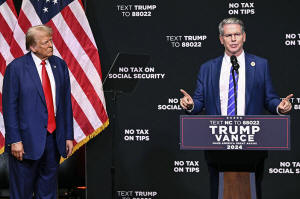The rising price of paying the national debt is a risk for Trump's
promises on growth and inflation
 Send a link to a friend
Send a link to a friend
 [November 25, 2024] By
JOSH BOAK and FATIMA HUSSEIN [November 25, 2024] By
JOSH BOAK and FATIMA HUSSEIN
WASHINGTON (AP) — Donald Trump has big plans for the economy — and a big
debt problem that will be a hurdle to delivering on them.
Trump has bold ideas on tax cuts, tariffs and other programs, but high
interest rates and the price of repaying the federal government’s
existing debt could limit what he’s able to do.
Not only is the federal debt at roughly $36 trillion, but the spike in
inflation after the coronavirus pandemic has pushed up the government's
borrowing costs such that debt service next year will easily exceed
spending on national security.
The higher cost of servicing the debt gives Trump less room to maneuver
with the federal budget as he seeks income tax cuts. It's also a
political challenge because higher interest rates have made it costlier
for many Americans to buy a home or new automobile. And the issue of
high costs helped Trump reclaim the presidency in November's election.
“It's clear the current amount of debt is putting upward pressure on
interest rates, including mortgage rates for instance," said Shai Akabas,
executive director of the economic policy program at the Bipartisan
Policy Center. “The cost of housing and groceries is going to be
increasingly felt by households in a way that are going to adversely
affect our economic prospects in the future.”

Akabas stressed that the debt service is already starting to crowd out
government spending on basic needs such as infrastructure and education.
About 1 in 5 dollars spent by the government are now repaying investors
for borrowed money, instead of enabling investments in future economic
growth.
It's an issue on Trump's radar. In his statement on choosing billionaire
investor Scott Bessent to be his treasury secretary, the Republican
president-elect said Bessent would “help curb the unsustainable path of
Federal Debt.”
The debt service costs along with the higher total debt complicate
Trump's efforts to renew his 2017 tax cuts, much of which are set to
expire after next year. The higher debt from those tax cuts could push
interest rates higher, making debt service even costlier and minimizing
any benefits the tax cuts could produce for growth.
“Clearly, it's irresponsible to run back the same tax cuts after the
deficit has tripled,” said Brian Riedl, a senior fellow at the Manhattan
Institute and a former Republican congressional aide. “Even
congressional Republicans behind the scenes are looking for ways to
scale down the president’s ambitions.”
Democrats and many economists say Trump's income tax cuts
disproportionately benefit the wealthy, which deprives the government of
revenues needed for programs for the middle class and poor.
"The president-elect’s tax policy ideas will increase the deficit
because they will decrease taxes for those with the highest ability to
pay, such as the corporations whose tax rate he’s proposed reducing even
further to 15%,” said Jessica Fulton, vice president of policy at the
Joint Center for Political and Economic Studies, a Washington-based
think tank that deals with issues facing communities of color.
Trump's team insists he can make the math work.
“The American people re-elected President Trump by a resounding margin
giving him a mandate to implement the promises he made on the campaign
trail, including lowering prices. He will deliver,” said Karoline
Leavitt, the Trump transition spokeswoman.
When Trump was last in the White House in 2020, the federal government
was spending $345 billion annually to service the national debt. It was
possible to run up the national debt with tax cuts and pandemic aid
because the average interest rate was low, such that repayment costs
were manageable even as debt levels climbed.
[to top of second column] |

Republican presidential nominee former President Donald Trump, left,
listens as investor Scott Bessent speaks on the economy in
Asheville, N.C., Aug. 14, 2024. (AP Photo/Matt Kelley, File)
 Congressional Budget Office
projections indicate that debt service costs next year could exceed
$1 trillion. That's more than projected spending on defense. The
total is also greater than nondefense spending on infrastructure,
food aid and other programs under the direction of Congress.
What fueled the increased cost of servicing the debt has been higher
interest rates. In April 2020, when the government was borrowing
trillions of dollars to address the pandemic, the yield on 10-year
Treasury notes fell as low as 0.6%. They're now 4.4%, having
increasing since September as investors expect Trump to add several
trillions of dollars onto projected deficits with his income tax
cuts.
Democratic President Joe Biden can point to strong economic growth
and successfully avoiding a recession as the Federal Reserve sought
to bring down inflation. Still, deficits ran at unusually high
levels during his term. That's due in part to his own initiatives to
boost manufacturing and address climate change, and to the legacy of
Trump's previous tax cuts.
People in Trump's orbit, as well as Republican lawmakers, are
already scouting out ways to reduce government spending in order to
minimize the debt and bring down interest rates. They have attacked
Biden for the deficits and inflation, setting the stage for whether
they can persuade Trump to take action.
Elon Musk and Vivek Ramaswamy, the wealthy businessmen leading
Trump's efforts to cut government costs, have proposed that the
incoming administration should simply refuse to spend some of the
money approved by Congress. It's an idea that Trump has also backed,
but one that would likely provoke challenges in court as it would
undermine congressional authority.
Russell Vought, the White House budget director during Trump's first
term and Trump's choice to lead it again, put out an alternative
proposed budget for 2023 with more than $11 trillion in spending
cuts over 10 years in order to potentially generate a surplus.
Michael Faulkender, a finance professor who served in Trump's
Treasury Department, told a congressional committee in March that
all the energy and environmental components of Biden's Inflation
Reduction Act from 2022 should be repealed to reduce deficits.
Trump has also talked up tariffs on imports to generate revenues and
reduce deficits, while some Republican lawmakers such as House
Budget Committee Chairman Jodey Arrington, R-Texas, have discussed
adding work requirements to trim Medicaid expenses.

The White House was last pressured by high rates to address debt
service costs roughly three decades ago during the start of Democrat
Bill Clinton's presidency. Higher yields on the 10-year Treasury
notes led Clinton and Congress to reach an agreement on deficit
reduction, ultimately producing a budget surplus starting in 1998.
Clinton political adviser James Carville joked at the time about how
bond investors pushing up borrowing rates for the U.S. government
could humble the commander in chief.
“I used to think that if there was reincarnation, I wanted to come
back as the president or the pope or as a .400 baseball hitter,"
Carville said. "But now I would like to come back as the bond
market. You can intimidate everybody.”
All contents © copyright 2024 Associated Press. All rights reserved |